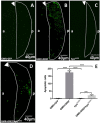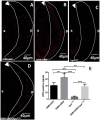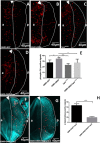The Hippo pathway as a target of the Drosophila DRE/DREF transcriptional regulatory pathway
- PMID: 25424907
- PMCID: PMC4244634
- DOI: 10.1038/srep07196
The Hippo pathway as a target of the Drosophila DRE/DREF transcriptional regulatory pathway
Abstract
The DRE/DREF transcriptional regulatory system has been demonstrated to activate a wide variety of genes with various functions. In Drosophila, the Hippo pathway is known to suppress cell proliferation by inducing apoptosis and cell cycle arrest through inactivation of Yorkie, a transcription co-activator. In the present study, we found that half dose reduction of the hippo (hpo) gene induces ectopic DNA synthesis in eye discs that is suppressed by overexpression of DREF. Half reduction of the hpo gene dose reduced apoptosis in DREF-overexpressing flies. Consistent with these observations, overexpression of DREF increased the levels of hpo and phosphorylated Yorkie in eye discs. Interestingly, the diap1-lacZ reporter was seen to be significantly decreased by overexpression of DREF. Luciferase reporter assays in cultured S2 cells revealed that one of two DREs identified in the hpo gene promoter region was responsible for promoter activity in S2 cells. Furthermore, endogenous hpo mRNA was reduced in DREF knockdown S2 cells, and chromatin immnunoprecipitation assays with anti-DREF antibodies proved that DREF binds specifically to the hpo gene promoter region containing DREs in vivo. Together, these results indicate that the DRE/DREF pathway is required for transcriptional activation of the hpo gene to positively control Hippo pathways.
Figures











Similar articles
-
The Drosophila histone methyltransferase NSD is positively regulated by the DRE/DREF system.Genes Genomics. 2018 May;40(5):475-484. doi: 10.1007/s13258-018-0649-5. Epub 2018 Feb 1. Genes Genomics. 2018. PMID: 29892958
-
The warts gene as a novel target of the Drosophila DRE/DREF transcription pathway.Am J Cancer Res. 2012;2(1):36-44. Epub 2011 Nov 22. Am J Cancer Res. 2012. PMID: 22206044 Free PMC article.
-
The DRE/DREF transcriptional regulatory system: a master key for cell proliferation.Biochim Biophys Acta. 2008 Feb;1779(2):81-9. doi: 10.1016/j.bbagrm.2007.11.011. Epub 2007 Dec 4. Biochim Biophys Acta. 2008. PMID: 18155677 Review.
-
Role of DREF in transcriptional regulation of the Drosophila p53 gene.Oncogene. 2010 Apr 8;29(14):2060-9. doi: 10.1038/onc.2009.483. Epub 2010 Jan 18. Oncogene. 2010. PMID: 20101238
-
DREF plays multiple roles during Drosophila development.Biochim Biophys Acta Gene Regul Mech. 2017 Jun;1860(6):705-712. doi: 10.1016/j.bbagrm.2017.03.004. Epub 2017 Mar 28. Biochim Biophys Acta Gene Regul Mech. 2017. PMID: 28363744 Review.
Cited by
-
The reproducibility of biomedical research: Sleepers awake!Biomol Detect Quantif. 2015 Jan 21;2:35-42. doi: 10.1016/j.bdq.2015.01.002. eCollection 2014 Dec. Biomol Detect Quantif. 2015. PMID: 27896142 Free PMC article. Review.
-
ZBED1/DREF: A transcription factor that regulates cell proliferation.Oncol Lett. 2020 Nov;20(5):137. doi: 10.3892/ol.2020.11997. Epub 2020 Aug 20. Oncol Lett. 2020. PMID: 32934705 Free PMC article. Review.
-
Phosphine inhibits transcription of the catalase gene through the DRE/DREF system in Drosophila melanogaster.Sci Rep. 2017 Oct 10;7(1):12913. doi: 10.1038/s41598-017-13439-4. Sci Rep. 2017. PMID: 29018235 Free PMC article.
-
Loss of putzig Activity Results in Apoptosis during Wing Imaginal Development in Drosophila.PLoS One. 2015 Apr 20;10(4):e0124652. doi: 10.1371/journal.pone.0124652. eCollection 2015. PLoS One. 2015. PMID: 25894556 Free PMC article.
-
The Drosophila histone methyltransferase NSD is positively regulated by the DRE/DREF system.Genes Genomics. 2018 May;40(5):475-484. doi: 10.1007/s13258-018-0649-5. Epub 2018 Feb 1. Genes Genomics. 2018. PMID: 29892958
References
-
- Hirose F., Yamaguchi M., Handa H., Inomata Y. & Matsukage A. Novel 8-base pair sequence (Drosophila DNA replication-related element) and specific binding factor involved in the expression of Drosophila genes for DNA polymerase alpha and proliferating cell nuclear antigen. J. Biol. Chem. 268, 2092–2099 (1993). - PubMed
-
- Matsukage A., Hirose F., Yoo M. A. & Yamaguchi M. The DRE/DREF transcriptional regulatory system: a master key for cell proliferation. Biochim. Biophys. Acta. 1779, 81–89, 10.1016/j.bbagrm.2007.11.011 (2008). - PubMed
-
- Yamaguchi M., Hayashi Y. & Matsukage A. Essential role of E2F recognition sites in regulation of the proliferating cell nuclear antigen gene promoter during Drosophila development. J. Biol. Chem. 270, 25159–25165 (1995). - PubMed
-
- Okudaira K. et al. Transcriptional regulation of the Drosophila orc2 gene by the DREF pathway. Biochim. Biophys. Acta. 1732, 23–30, 10.1016/j.bbaexp.2005.10.009 (2005). - PubMed
Publication types
MeSH terms
Substances
LinkOut - more resources
Full Text Sources
Other Literature Sources
Molecular Biology Databases

